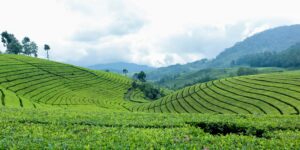Tea, as an important part of Chinese traditional culture, has a long and rich history. It is not only a drink, but also a symbol of culture, etiquette and philosophical thought. This article will explore the origin, development process, cultural significance and impact of Chinese tea on the world.
1. Origin of Tea
China is the hometown of tea, and the history of tea can be traced back to the mythological era around 2737 BC. According to the records of Shennong’s Herbal Classic, Emperor Yan Shennong discovered the magical effect of tea when he tasted hundreds of herbs. According to legend, he accidentally ate poisonous plants and fainted. After waking up, he found that his body gradually recovered after drinking tea. This made tea considered a good medicine for detoxification and health care.
2. The spread and development of ancient tea
1. Zhou Dynasty (1046 BC-256 BC)
Tea was already a drink for the nobility in the Zhou Dynasty, mainly used for banquets and sacrificial activities. Because of its preciousness, tea was often regarded as a tribute and favored by princes and nobles.
2. Han Dynasty (206 BC-220 AD)
During the Han Dynasty, with the opening of the Silk Road, tea began to spread in Central Asia. During this period, tea gradually became a daily drink for the people. The famous medical scientist Hua Tuo mentioned the medicinal value of tea, which further promoted the popularity of tea.
3. Wei, Jin, Southern and Northern Dynasties (220 AD-589 AD)
During this period, tea consumption gradually expanded to the south, especially in the Jiangnan region. Tea began to develop unique brewing and drinking methods, and the drinking methods of “grinding tea” and “brewing tea” appeared. At the same time, tea culture also gradually took shape, and literati began to use tea to chant poems and compose fu.
4. Tang Dynasty (618 AD-907 AD)
The Tang Dynasty was the peak period of Chinese tea culture. Tea planting and production technology continued to improve, and famous teas such as “Longjing” and “Biluochun” began to gain reputation. The way of drinking tea also evolved from the initial “boiling tea” to “brewing tea”. Lu Yu’s “The Classic of Tea” was published during this period, systematically summarizing the types, production and drinking methods of tea, and is known as the “encyclopedia” of tea.
5. Song Dynasty (960 AD-1279 AD)
During the Song Dynasty, tea culture became more mature. The emergence of teahouses made tea drinking more popular, and the tea ceremony was gradually established. The tea art of the Song Dynasty emphasized the combination of tea and utensils, and also promoted the artistic development of tea utensils. At the same time, literati exchanged ideas and chanted through drinking tea, forming the custom of “tea party”.
6. Yuan Dynasty to Ming Dynasty (1271 AD-1644 AD)
During the Yuan Dynasty, the trade of tea gradually became internationalized and became an important commodity for exchanges with the West. In the Ming Dynasty, traditional cake tea was gradually replaced by loose tea, the varieties and production processes of tea were more abundant, and the planting and production of “black tea” emerged. The famous “Wuyi Rock Tea” was produced at this time.
7. Qing Dynasty (1644-1912 AD)
During the Qing Dynasty, tea culture reached its peak, and the varieties of tea covered almost all the famous teas in China. The tea ceremony of this period emphasized the creation of atmosphere, and the tea art reached the height of art. At the same time, tea, as an important commodity, began to spread all over the world and became an important commodity in international trade.
III. The cultural significance of tea
Tea is not only a drink, but also carries a profound cultural heritage. In China, drinking tea has become a way of social activity and cultural communication. Whether it is at home, at a gathering of friends, or at a formal occasion, tea is an important social medium.
Etiquette culture: In traditional Chinese etiquette, serving tea is an important way to express respect and gratitude. Whether it is serving tea between elders or pleasing and blessing at a wedding, tea occupies an important position.
Philosophical concept: Tea culture is closely related to China’s Confucian and Taoist culture. Tea is regarded as a spiritual sustenance, and drinking tea is a way to cultivate one’s character and pursue inner peace.
Literary creation: Many literati expressed their emotions through tea, leaving behind a large number of tea poems, tea articles and tea paintings, and tea has become an important element of cultural creation.
IV. The influence of Chinese tea on the world
With the development of the times, Chinese tea has gradually gone to the world, influencing and enriching the tea culture of other countries. Since the 17th century, tea has been introduced to Europe and has become a luxury for the nobility and the upper class, and later it has been popularized to the public. With the British preference for tea, a unique “British afternoon tea culture” has been formed.
Today, the international influence of Chinese tea continues to expand. It not only exports various famous teas to the world, but also promotes the recognition and learning of Chinese tea culture around the world. For example, in recent years, with the improvement of the concept of healthy diet, more and more international brands have begun to pay attention to healthy drinks such as green tea and oolong tea, which has promoted the globalization of Chinese tea.
Conclusion
Chinese tea has a long history and rich cultural connotations. As an important part of Chinese traditional culture, tea is not only a drink in people’s daily life, but also a medium for cultural exchange. The spread and development of tea shows the wisdom of the Chinese people and their pursuit of quality of life. In the future, with the global attention to healthy drinks, Chinese tea culture will continue to flourish and influence more people.
Write an introduction to the birthplace of tea 1000 words
Sider Fusion
Introduction to the birthplace of tea
Tea, as China’s traditional national drink, has a long history and extensive cultural influence. As the birthplace of tea, China’s tea culture is deeply rooted and closely related to the development of Chinese civilization. This article will focus on the birthplace of tea in China, including the legend of the origin of tea, the main tea-producing areas, and their important position in the development of tea culture and tea industry.
1. Legend of the origin of tea
There are many legends about the true origin of tea in history. The most popular and widely accepted one is the legend about Shennong in ancient China. According to legend, in 2737 BC, Emperor Yan Shennong accidentally ate a poisonous plant in order to detoxify while tasting hundreds of herbs and fainted on the ground. At this time, the tea leaves beside him fell into the boiling water, producing a peculiar aroma and taste, which gradually restored his consciousness. From then on, tea was discovered and became a drink that is both delicious and beneficial to health.
2. Main tea producing areas
The origin of tea in China is concentrated in several regions, mainly including:
1. Yunnan Province
Yunnan is regarded as the motherland of tea, and its unique climate and soil conditions are very suitable for the growth of tea trees. The “large-leaf” tea trees here are the raw materials of Pu’er tea, which is famous for its mellow taste and rich medicinal value. Yunnan has a long tea culture, and tea as a social medium is deeply rooted in the hearts of the people. Every year, the “Ancient Tea Horse Road” brings Yunnan tea to the southwest and Tibet, forming a unique phenomenon of “tea and cultural integration”.
2. Fujian Province
Fujian Province, especially the Wuyi Mountain area, is famous for its characteristic rock tea, such as Dahongpao, cinnamon, etc. Fujian is the birthplace of oolong tea, and its unique production process makes the tea more complex in aroma and taste. In addition, tea culture has been infiltrated in Fujian for a long time, and the custom of drinking tea has been integrated into the lifestyle of local people, becoming their etiquette for hospitality and a bond for social interaction.
3. Zhejiang Province
Zhejiang Province is famous for Longjing tea (West Lake Longjing), one of the top ten famous teas in China. The tea trees grow under specific climate and soil conditions, which creates its unique aroma and taste. West Lake Longjing is deeply loved by tea lovers for its clear soup color and sweet aroma. Zhejiang’s tea culture is also widely respected. Many historical literati have used tea as a theme, leaving behind rich cultural heritage.
4. Guangdong Province
Guangdong Province is one of the main tea producing areas in China, among which Pu’er tea and Oolong tea are the most famous. Tieguanyin is one of the advantageous teas in Guangdong. This tea is famous for its unique stir-frying process and rich tea fragrance. In addition, Guangdong’s tea drinking culture is represented by Cantonese-style morning tea, and tea drinking has become an indispensable part of people’s daily life.
5. Anhui Province
Anhui Province is famous for its high-quality green tea. Famous teas such as Huangshan Maofeng and Lu’an Guapian are well-known at home and abroad. The climate and terrain of Anhui are suitable for the growth of tea trees, forming a rich tea garden landscape. The tea culture here has a profound historical background, and many tea-related poems and literati stories originated from this.
3. The influence of tea culture
As the birthplace of tea, China’s major tea-producing areas are not only the origin of tea, but also an important carrier of tea culture. The planting, picking and production processes of tea are integrated with the unique local customs and habits, forming a rich and colorful tea culture.
1. Social culture
Tea plays an extremely important role in the daily life of Chinese people. In family gatherings and among friends, tea drinking is often a medium of conversation, conveying enthusiasm and hospitality. Cultural customs such as respecting elders and tea-serving etiquette make the relationship between people closer.
2. Literature and art
Many poets, painters and calligraphers in ancient China used tea as the theme and created a large number of poems and calligraphy works. For example, “Asking about Tea” by Bai Juyi, a poet in the Tang Dynasty, and “Drinking on the Lake After Sunny and Rainy” by Fan Zhongyan in the Song Dynasty all show the unique charm of tea in literature and art.
3. Health and health
With the development of the times, the health value of tea is valued by more and more people. Tea contains a variety of healthy ingredients such as rich antioxidants, lipid-lowering and digestion-promoting, making it an important choice for modern people to pursue a healthy life.
4. The international influence of tea
The birthplace of Chinese tea not only affects the domestic tea drinking culture, but also spreads around the world with trade and exchanges. In the 17th century, tea was introduced to Europe through maritime trade and became a luxury for the nobility and the upper class. It was eventually popularized among the general public, forming a unique “British afternoon tea culture”.
Today, with the increasing global attention to healthy drinks and people’s in-depth understanding of tea culture, various Chinese famous teas have successively gone abroad and become an important part of the global market.
Conclusion
China is the birthplace of tea and has a long history of tea and rich tea culture. The types and flavors of tea in Yunnan, Fujian, Zhejiang, Guangdong, Anhui and other places are unique and carry a deep cultural heritage. With the blessing of Chinese traditional culture and health concepts, tea is not only deeply rooted in the hearts of the people in China, but also widely spread around the world. In the future, we hope that more people can understand and experience the charm of tea and walk into this lush and culturally rich birthplace of tea.










Leave a reply